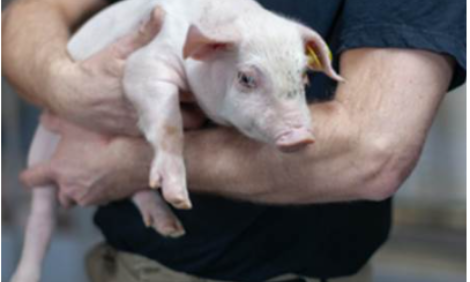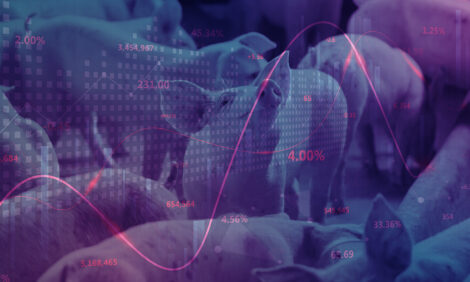



US Pork Outlook – July 2011
Drought continues to drive US cattle sales, while pig meat exports are expected to continue to be strong and broiler meat production continues to rise, according to the latest Livestock, Dairy, and Poultry Outlook from the USDA's Economic Research Service.Summary
The Quarterly Hogs and Pigs report indicated the highest ever litter rate of 10.03 for the March-May pig crop. Expectations for continued strong exports and only slightly higher second-half pork production will likely support hog prices and retail pork prices at least until the end of the year. May exports continued a string of double-digit increases over 2010, with China now routinely one of the top-10 destinations for US pork products.
Pigs per Litter Record-High on 1 June
US hog producers broke through the 10-pigs-per litter barrier in the March-May quarter, according to the Quarterly Hogs and Pigs report, released by USDA on 24 June. The report indicated a litter rate of 10.03 pigs per litter, or 2.2 per cent higher than the litter rate of the spring quarter a year ago. The 10.03 pigs per litter mark positions the US hog production industry to possibly surpass Canadian hog producers’ longstanding litter-rate lead. Canada will report its April-June metrics on 22 August.
US litter rates have trended upwards for more than two decades, but the 10+ pigs per litter mark had never been achieved until March-May 2010. Several factors likely culminated to push the US hog production industry to 10+ pigs-per-litter mark in the second quarter.

Genetic improvement – the ability to identify, select and incorporate strong breeding characteristics in the reproductive herd – is a key factor in accelerated US litter rates. A generalised industry adoption of innovations in technology that improve animal handling procedures, breeding methods and nutritional composition are also among the major factors contributing to larger litters, superior survival rates and improved weaned-pig numbers. It is also hard to minimise the importance of management and labour coordination in large breeding programmes, both of which have received significant industry attention in recent years. Finally, while structural change in the US hog industry has received exhaustive attention from economists, it is hard to overestimate the reproductive implications that derive from an industry that has moved from a very large number of small operations to a relatively small number of very large, specialised operations.
It is notable that the litter rates of major hog-producing states, Iowa and Minnesota, have led the pack, exceeding the US average and effectively pulling the country’s average over the 10 pigs per litter mark.

Canada’s Lead in Spring-Quarter Litter Rates in Jeopardy
The record-high second-quarter litter rate achieved by US hog producers sets up the US industry to surpass Canada’s long-standing lead in this production metric.
While the Canadian industry as a whole has yet to achieve a 10+ litter rate in its spring-quarter production, one province in particular, Manitoba, has consistently scored a 10+ litter rate in each quarter since 2004. Manitoba’s spring-quarter litter rate peaked at 10.7 in 2009, however, and it appears to be trending lower. The downward trend is likely a consequence of lower investment in reproductive maintenance and technologies, brought about by negative producer returns in recent years. Looking ahead, the high valued exchange rate of the Canadian dollar, along with expectations for continued imposition of restrictive provincial environmental regulations, will likely continue to stress Manitoba producers, with implications for litter rates.


Despite June Report Revisions, Fourth-Quarter Production Likely To Be Slightly Below a Year Ago
The June report also indicated that higher actual farrowings in March-May accompanied the record-high spring litter rates. Nevertheless, spring farrowings were 1.8 per cent below March-May of 2010, which, when combined with record-high litter rates, yielded a spring pig crop only slightly higher than a year ago (+0.42 per cent year-over-year). While the spring pig crop points to slightly higher fourth-quarter slaughter, dressed weights will likely average below 2010 levels, which were achieved when a combination of corn-quality and optimal feeding weather boosted weight gains. Fourth-quarter commercial pork production is expected to be 6.1 billion pounds, or about one per cent below fourth-quarter 2010. Combining expected fourth-quarter pork production with third quarter’s expected two per cent higher production of 5.5 billion pounds implies slightly higher second-half pork production – less than one per cent above second-half 2010.
Despite expectations of slightly higher second-half production, second-half exports are anticipated to come in at more than 12 per cent ahead of second-half 2010, suggesting lower second-half 2011 domestic pork disappearance. Consequently, continued year-over-year higher hog prices and unusually high retail pork prices are the most likely outcome for second-half 2011. Third-quarter prices of live equivalent 51 to 52 per cent lean hogs are expected to be $67-69 per cwt, 13 per cent above the same period last year. In the fourth quarter, hog prices are expected to be $58-$62 per cwt, about 20 per cent above a year earlier. Second-half retail pork prices are expected to be in the high $3.30s to low $3.40s per pound.
May Exports Continue Strong 2011 Trend
May pork exports of almost 409 million pounds – 12.7 per cent greater than a year ago – continued a trend of double-digit year-over-year increases in exports that began late last year. The top three foreign destinations for US pork products in May were Japan (+16.4 per cent), Mexico (+26.9 per cent) and Canada (+15.1 per cent), and together these three countries accounted for 66 per cent of US exports. Exports to South Korea and China rounded out the top five destinations in May. Shipments to South Korea of 30.2 million pounds were 32.7 per cent higher than in May 2010; this increase is more than likely attributable to product deficits created by FMD problems earlier in the year. Moreover, the South Korean Government recently further relaxed pork import restrictions, implying that demand for US pork products will likely stay strong.
China Returns as an Important Export Destination for US Pork
Since the second half of 2010, China has stepped up its demand for US pork and now routinely ranks in the top 10 – often in the top 5 – of US export destinations. China was the fifth largest export destination in May, importing 23.7 million pounds of US pork. Comparisons of current Chinese purchases with recent past US shipments are difficult, because of restrictions placed by the Chinese on US pork due to concerns about H1N1. With this restriction removed in May 2010, China has developed a pattern of consistent purchases of important quantities of US pork products.
Some perspective is gained, however, by comparing May 2011 China exports to those of Japan. Exports to Japan in January-May were 627 million pounds, or, almost five times more than exports to China. January-May exports to Japan accounted for 30 per cent of total US exports; shipments to China accounted for six per cent. China is becoming an important outlet for US pork products but shipments are currently relatively small compared with Japan and Mexico, the United States’ two largest export destinations. However, China’s evolution as an export destination for US pork products is likely to continue to evolve.

Further Reading
| - | You can view the full report by clicking here. |
July 2011








